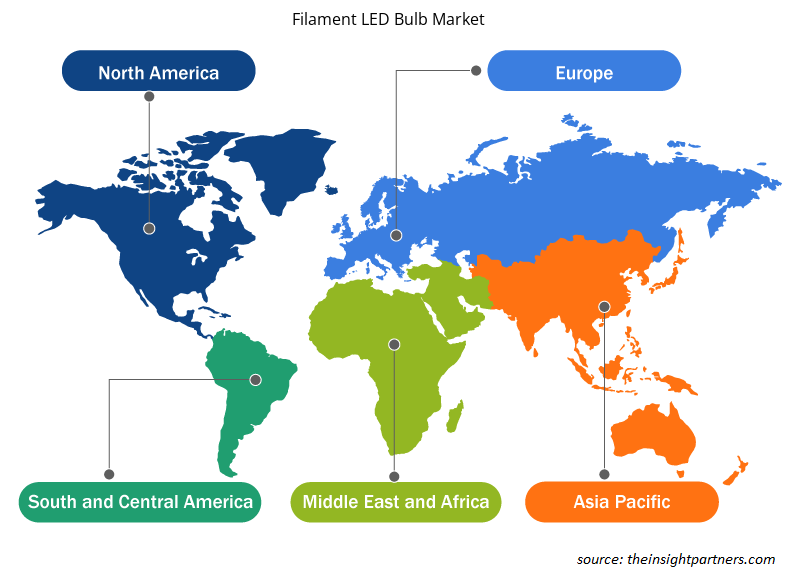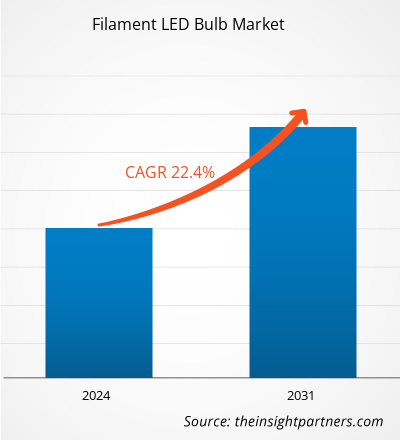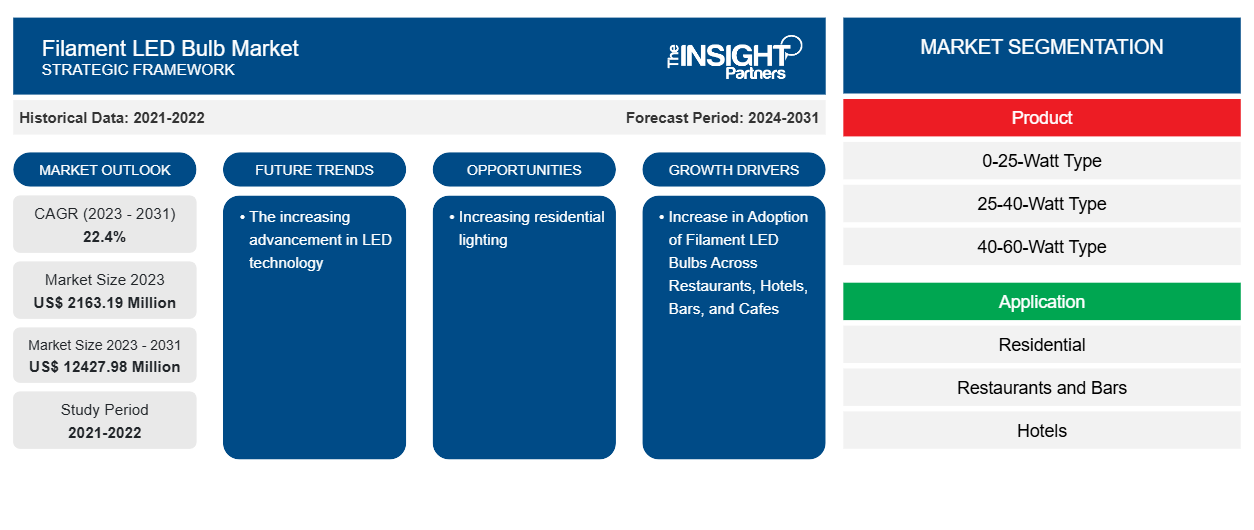预计到 2031 年,灯丝 LED 灯泡市场规模将从 2023 年的 21.6319 亿美元增至 124.2798 亿美元。预计 2023-2031 年期间市场复合年增长率将达到 22.4%。LED 技术的不断进步可能仍是市场的主要趋势。
灯丝型 LED 灯泡市场分析
市场的增长归因于不同地区的商业和住宅建设项目数量的增加。此外,人们对房屋翻修和改造活动的兴趣增加(这可能与政府(特别是在工业化国家)的支持增加有关)也推动了对灯丝 LED 灯泡的需求。消费者收入水平的提高、生活方式的改变以及室内装饰方面对多元文化的接受都促进了这种转变。
灯丝型 LED 灯泡市场概况
LED 灯丝灯泡增强了白炽灯泡的外观和光散射,同时使用 LED 技术提供高效照明和可靠的性能。LED 灯丝灯泡,通常称为爱迪生灯泡,通过透明玻璃外壳显示大型发光灯丝,类似于老式白炽灯或复古灯。LED 灯丝灯泡具有传统白炽灯泡的外观,同时提供节能照明和传统 LED 照明的所有其他优点。LED 灯丝灯泡的使用寿命比白炽灯泡更长。
定制此报告以满足您的需求
您可以免费定制任何报告,包括本报告的部分内容、国家级分析、Excel 数据包,以及为初创企业和大学提供优惠和折扣
-
获取此报告的关键市场趋势。这个免费样品将包括数据分析,从市场趋势到估计和预测。
灯丝 LED 灯泡市场驱动因素和机遇
餐厅、酒店、酒吧和咖啡馆中灯丝 LED 灯泡的采用率增加
照明是餐厅和咖啡厅整体设计中的重要元素。在咖啡厅、酒吧和餐厅中,通常认为 150 勒克斯的光强度是合适的。其他区域需要 100 勒克斯,食物储藏区需要 150 勒克斯,洗涤区需要 300 勒克斯,烹饪区需要 500 勒克斯。餐厅采用四种类型的照明:一般照明、重点照明、装饰照明和自然照明。在咖啡厅或餐厅中,一般照明是最重要的方面。通过同时按一定顺序放置照明设备可实现均匀照明。如果餐厅的整体装饰得体,顾客会觉得餐厅更受欢迎。重点照明可用于吸引人们对餐厅的主要或花哨方面的注意,包括装饰、植物、桌子或商品。装饰照明是指用于完成设计的照明组件。传统和现代照明可用于创造装饰照明。因此,餐厅、酒店、酒吧和咖啡馆使用的各种照明技术正在推动灯丝 LED 灯泡的采用,从而促进市场增长。
增加住宅照明
住宅区照明正在增加。家庭中 LED 灯泡的使用与其他家庭特征不同,例如家庭收入和所有权。在年收入低于 20,000 美元的家庭中,39% 表示 LED 灯泡是他们的主要室内照明选择,而 54% 的年收入 100,000 美元或以上的家庭在 2020 年主要使用 LED 灯泡。灯丝 LED 灯泡在住宅区广泛使用。因此,住宅照明的增加为灯丝 LED 灯泡市场创造了更多机会。
灯丝 LED 灯泡市场报告细分分析
有助于得出灯丝 LED 灯泡市场分析的关键部分是产品和应用。
- 根据产品,灯丝 LED 灯泡市场分为 0-25 瓦型、25-40 瓦型、40-60 瓦型和 60 瓦以上型。0-25 瓦型在 2023 年占据了较大的市场份额。
- 根据应用,市场分为住宅、餐厅和酒吧、酒店、咖啡馆和其他。
灯丝 LED 灯泡市场份额按地区分析
灯丝LED灯泡市场报告的地理范围主要分为五个区域:北美、亚太、欧洲、中东和非洲、南美和中美。
2023 年,欧洲引领了灯丝 LED 灯泡市场。在欧洲,国家能源效率行动计划 (NEEAP) 和国家能源效率行动计划 (NEEAP) 等旨在促进对住宅和商业建筑维护和翻新的投资。此外,消费者愿意在生活空间的造型上花费大量资金,这吸引了他们对地毯和地毯等家居产品以及提升室内美感的先进和时尚照明系统的关注。
灯丝 LED 灯泡市场区域洞察
Insight Partners 的分析师已详尽解释了预测期内影响灯丝 LED 灯泡市场的区域趋势和因素。本节还讨论了北美、欧洲、亚太地区、中东和非洲以及南美和中美洲的灯丝 LED 灯泡市场细分和地理位置。

- 获取灯丝 LED 灯泡市场的区域特定数据
灯丝 LED 灯泡市场报告范围
| 报告属性 | 细节 |
|---|---|
| 2023 年的市场规模 | 21.6319亿美元 |
| 2031 年市场规模 | 124.2798 亿美元 |
| 全球复合年增长率(2023 - 2031) | 22.4% |
| 史料 | 2021-2022 |
| 预测期 | 2024-2031 |
| 涵盖的领域 |
按产品
|
| 覆盖地区和国家 |
北美
|
| 市场领导者和主要公司简介 |
|
灯丝 LED 灯泡市场参与者密度:了解其对业务动态的影响
灯丝 LED 灯泡市场正在快速增长,这得益于终端用户需求的不断增长,而这些需求又源于消费者偏好的不断变化、技术进步以及对产品优势的认识不断提高等因素。随着需求的增加,企业正在扩大其产品范围,进行创新以满足消费者的需求,并利用新兴趋势,从而进一步推动市场增长。
市场参与者密度是指在特定市场或行业内运营的企业或公司的分布情况。它表明在给定市场空间中,相对于其规模或总市场价值,有多少竞争对手(市场参与者)存在。
在灯丝 LED 灯泡市场运营的主要公司有:
- 克朗普顿灯具有限公司
- 哈维尔印度有限公司
- Wipro 消费照明
- 曼佳美
- 欧司朗有限公司
- 飞利浦照明控股公司
免责声明:上面列出的公司没有按照任何特定顺序排列。

- 获取灯丝 LED 灯泡市场顶级关键参与者概览
灯丝 LED 灯泡市场新闻和最新发展
灯丝 LED 灯泡市场通过收集一手和二手研究后的定性和定量数据进行评估,其中包括重要的公司出版物、协会数据和数据库。灯丝 LED 灯泡市场的一些发展情况如下:
- Feit Electric Company, Inc.(“Feit Electric”)是一家总部位于加利福尼亚州的全球领先照明和智能家居品牌,今天宣布其创新型可见白色灯丝灯泡获得一系列专利保护,即“白色灯丝专利”。
(来源:Trellix,新闻稿,2023 年 10 月。)
- 此外,Life on Products, Inc. 于 1 月发布了更多 LED 灯丝灯。(来源:PamTen Inc,新闻稿,2023 年 1 月)
灯丝 LED 灯泡市场报告覆盖范围和交付成果
“灯丝 LED 灯泡市场规模和预测(2021-2031 年)”报告对市场进行了详细分析,涵盖以下领域:
- 灯丝 LED 灯泡市场规模以及全球、区域和国家层面所有主要细分市场的预测,涵盖范围
- 灯丝 LED 灯泡市场趋势以及市场动态,如驱动因素、限制因素和关键机遇
- 详细的 PEST/波特五力分析和 SWOT 分析
- 灯丝 LED 灯泡市场分析,涵盖主要市场趋势、全球和区域框架、主要参与者、法规和最新市场发展
- 行业格局和竞争分析,涵盖市场集中度、热点图分析、知名参与者以及灯丝 LED 灯泡市场的最新发展
- 详细的公司简介
- 历史分析(2 年)、基准年、预测(7 年)及复合年增长率
- PEST和SWOT分析
- 市场规模、价值/数量 - 全球、区域、国家
- 行业和竞争格局
- Excel 数据集
近期报告
客户评价
购买理由
- 明智的决策
- 了解市场动态
- 竞争分析
- 客户洞察
- 市场预测
- 风险规避
- 战略规划
- 投资论证
- 识别新兴市场
- 优化营销策略
- 提升运营效率
- 顺应监管趋势























 获取免费样品 - 灯丝LED灯泡市场
获取免费样品 - 灯丝LED灯泡市场